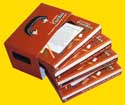Fall 2000
A Journalist’s ToolBox
Building New Routines and Reflexes
By Dana Clark Felty
Pew Center
The complex decisions and core values of citizens are hard to capture in a quote or a sound bite. New sources and renewed trust from underreported communities are hard to cultivate under daily deadlines. And when conflict and controversy enter the public arena, it’s often the loudest and most extreme voices that set the frames for news coverage.
Enter the changing geography of journalism: Newsrooms are now responsible for covering scores of additional communities. And factor in how the communities themselves are being reinvented amid new populations and new growth.
It’s a daunting task for journalists to get the right stories.
 A set of four new videos by the Pew Center for Civic Journalism offers some practical tools to help journalists learn about what’s happening in their communities and to better reflect that in their news reports. They will also help better prepare journalism students for today’s reporting challenges.
A set of four new videos by the Pew Center for Civic Journalism offers some practical tools to help journalists learn about what’s happening in their communities and to better reflect that in their news reports. They will also help better prepare journalism students for today’s reporting challenges.
The video kit, “A Journalist’s Toolbox,” draws on the techniques and experiences of working journalists at The Charlotte Observer, The Orange County Register, the Tampa Tribune, The Virginian-Pilot and Tampa’s WFLA-TV.
Each 13-minute video demonstrates the strategies that journalists around the country are using on a daily basis to conduct better interviews, frame better stories, and tap new sources and stories in their communities.
“Journalists need to retool some core competencies to met today’s reporting realities,” said Jan Schaffer, the Pew Center’s executive director. “This video toolkit is one of our most extensive efforts to help civic journalists enlarge their skills beyond project journalism and to help all journalists develop some new routines and reflexes.”
The videos build on the work of Richard Harwood, president of The Harwood Institute for Public Innovation, who has conducted Civic Mapping Seminars for the Pew Center and has served as a consultant for many news organizations.
The videos complement a newly revised workbook, “Tapping Civic Life. How to Report First, and Best, What’s Happening in Your Community,” a do-it-yourself manual for injecting fresh voices and citizen concerns into daily journalism.
“We have reflexes that tell us to run to our Rolodex when a story comes about and to go to the people we’ve seen before or heard before because a) we know they’ll answer our call; b) we know they’ll be articulate; c) we know they’re going to have a quote; d) we know they’re probably going to be able to back it up with facts,” Harwood says.
“Well, you may need people like that in your story. But that’s a definition of knowledge that does not fit with the knowledge that we know exists within a society.”
The videos, for instance, demonstrate how some questions can shut down an interview and how others can open up a conversation. They show how one question: “What do you make of that?” can help journalists discern the real meaning behind peoples’ comments.
“There are certain kinds of questions reporters can ask to better grasp the reasoning behind the quotes they write down,” Harwood says. “That’s important because people don’t always say what they think or, more likely, are not used to putting their thoughts into quotes.”
Knowing the thinking behind a quote enables reporters to write with more accuracy. And stories connect better with communities because issues and events are explained in the same terms readers and viewers use.
“It’s not hard to find out what’s on people’s minds. Everybody’s worried about crime. Everybody’s worried about schools,” says Charlotte Observer reporter Dan Chapman. “But, then again, getting beneath the surface you find out, well, maybe my issue over here is ‘I don’t like that convenience store because that’s where a lot of bums and drug addicts hang out’ and ‘I don’t think they should be selling 40-ounce beers and those little glass vials that can be turned into crack pipes.’
“We may not have known that unless we spent time, and I did spend time, in stores like that talking to people,” Chapman says.
Virginian-Pilot business reporter Karen Weintraub explains how, during a strike of 7,000 shipyard workers, she got beyond the speechmaking and discovered themes and tensions she never imagined existed.
“I went on an interview for the strike story with another reporter and he churned through several people while I was still talking to the same ones,” Weintraub said. “But I would argue I got more by staying with the same people than he got by moving. So it was the same total time, but I think I felt better about what I had. I didn’t get a quote. I got a story.”
Ken Koehn, a government reporter at the Tampa Tribune, used the same technique when he explored a community targeted for redevelopment.
“When you get out and just meet people without a preconceived story and say, ‘Hey, I just want to talk to you,’ it’s amazing the complex conversations you can get into,” Koehn said. “They discuss issues more openly, they’re not as suspicious of you because they feel like you’re calling them up just for a quote – when that’s exactly what you’re doing. And your stories just, they ring more true. They sound authentic because they are.”
The videos come with a discussion guide to help newsrooms and classrooms engage in ways to improve their journalism. To order the four-video set, “A Journalist’s Toolbox,” send $10 (checks only) to cover mailing and packaging, to the Pew Center for Civic Journalism. Check out the full transcripts and ordering information > > >
